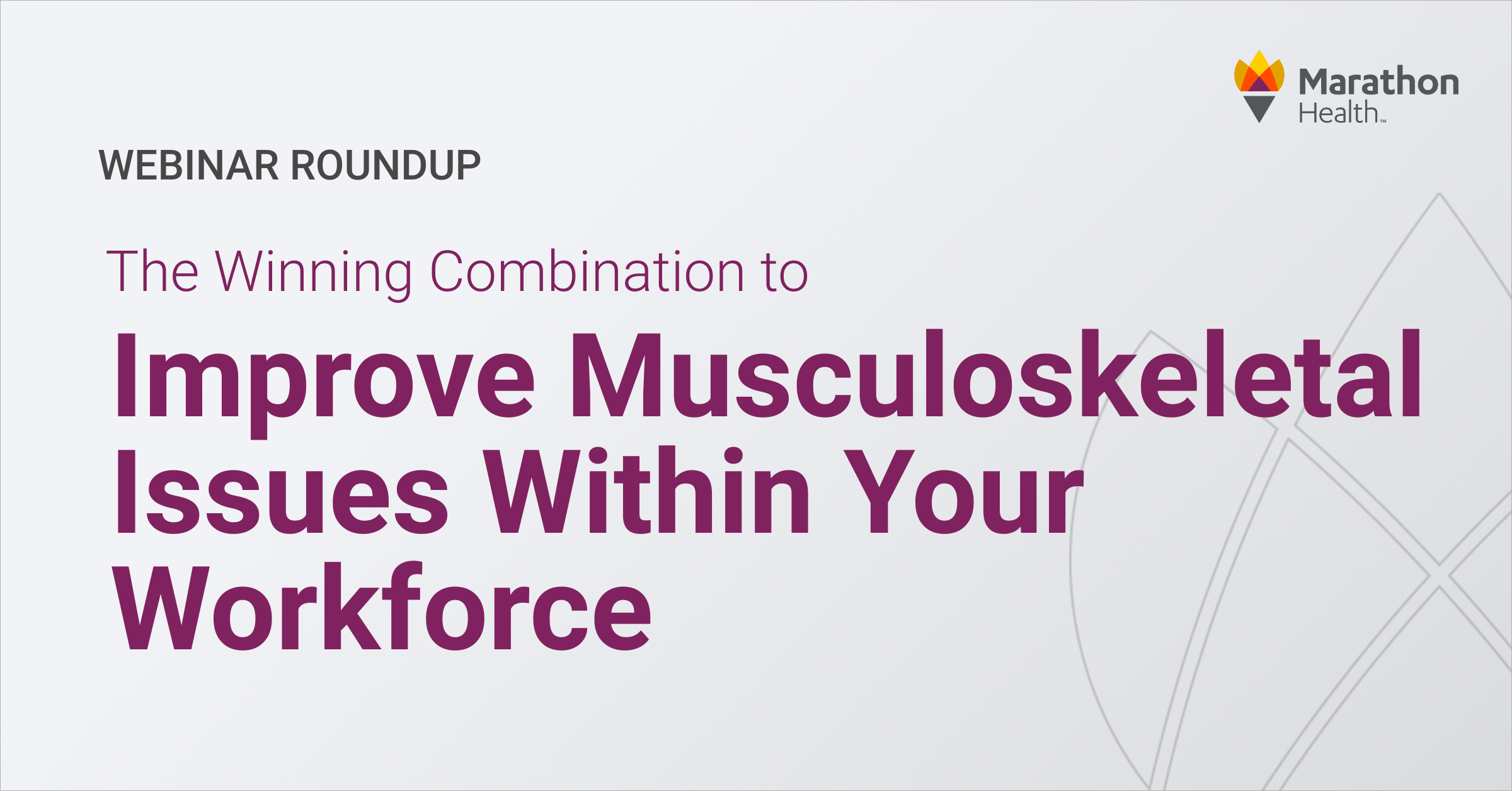Musculoskeletal issues fall within the top three cost drivers for many businesses and unions across the country. In fact, 50% of adults will experience some form of the condition in their life, causing physical and mental pain that affects both their work and family life.
As part of our recent webinar, The Winning Combination to Improve Musculoskeletal Issues Within Your Workforce, host Shelly Towns, CMO of Marathon Health, spoke to our panel about how the best employer and union healthcare models incorporate physical therapy with primary care, health coaching and behavioral health to reduce pain, improve patient outcomes and cut costs.
The roundtable discussion includes great insights from:
Jon Strychasz, PT, Cert MDT, Cert DN, who serves as the National Director of Physical Therapy at Marathon Health
Michael Muzic, a 32-year member of the International Brotherhood of Electrical Workers (IBEW) Local 38 in Cleveland, Ohio, who has served as elected President since 2017
Christine Reichardt, Manager of Benefits for Briggs & Stratton in Milwaukee, who is responsible for benefits, employee wellness and workers’ compensation
Watch the Full Webinar — Improving Musculoskeletal Issues Within Your Workforce
Physical Therapy within an Integrated Care Teams Improves Employee Musculoskeletal Issues
During the webinar, Jon shared how much of a burden musculoskeletal conditions place on both employees and their employers. “If we look at our book of business, musculoskeletal claims are usually one of the top three drivers of cost,” he says. “We know that one in two adults over age 18 have a musculoskeletal condition at some point in their life. And, low back pain is one of the top drivers of healthcare costs. It’s really kind of an epidemic, right? We don’t consider it that, but it really is.”
Physical therapy in conjunction with an integrated care team approach can ease the burden of these issues. It starts with understanding the employer’s needs and creating an individualized approach for each population. Jon says it’s important physical therapists see how employees work in their daily setting.
By getting members and employees in the door for physical therapy at the onsite health centers, Jon, Mike and Chris all shared how it’s a step toward better holistic health, too. Physical therapists can encourage patients to leverage primary care or behavioral health care offerings since they have access to an integrated care team. The physical therapist might try to get a biometric screening scheduled, or a comprehensive health review so patients can understand their overall health and well-being.
Michael discussed his own success story about dealing with shoulder pain that he later learned stemmed from a neck issue. “I CAN tell you how to put electricity in a building. I CAN’T tell you how to fix a shoulder,” Michael says. “Jon sees what the IBEW team members do every day and understands what our problems are going to be. And, he fixed my pain within a few sessions. … By offering physical therapy, we’re trying to fix any musculoskeletal issues and get people back to work.”
Jon says that union members can see a physical therapist without a primary care referral, too. “Even a doctor’s appointment is time away from work. And if these union members don’t work, they’re not getting paid. We educate them so they can manage or improve their condition so they can stay on the job.”
Prevention of Employee Musculoskeletal Issues
Briggs & Stratton has offered onsite care teams for more than 15 years, and Chris says adding physical therapy was an easy decision for their manufacturing population. “It has to be about population health,” she says. “I want to make sure our employees are safe at work. And if they have something happen to them at work or outside of work, they have an outlet and support. It’s important to make people feel valued.”
Chris says their team has really focused on the prevention of musculoskeletal issues as well. This past year, they launched an Industrial Athlete program to help people understand the mechanics of their body and the importance of stretching in advance of work and throughout the day to help prevent or reduce pain. “It becomes empowering,” she says. “We’re seeing more people come into the office for their primary care now, and we’re seeing more people trust those physical therapists as advisors on their health in general. It’s reducing barriers to care.”
Watch the full video to learn how an integrated primary care model with physical therapy might benefit your population.
Additional Content You Might Like
How to Make Employee Wellness Programs Successful
How Total Rewards Strategies are Changing HR Today
A Day in the Life: Referral Coordinator Helps Employees Navigate Healthcare System
You might also like
Subscribe to our newsletter and stay on the cutting edge of worksite healthcare.






